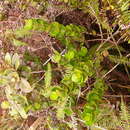en
names in breadcrumbs


Alyxia is an Australasian genus of flowering plant in the dogbane family, Apocynaceae. It contains at present 106 species, but Alyxia stellata and A. tisserantii are very variable, might be cryptic species complexes, and are need of further study. It consists of shrubby, climbing or scrambling plants. This genus occurs in China, the Himalayas, Southeast Asia, Australia, New Caledonia and the Pacific Islands. There are 14 species in Australia, 21 in New Caledonia and 7 in the other Pacific Islands, including Hawaiʻi.[3]
The leaves are opposite or in whorls of three to seven. There are colleters (groups or tufts of mucilaginous secretory hairs) present in the leaf axils. The inflorescence is axillary or terminal with solitary flowers or simple cymes. Flowers consist of five petals and five sepals. The flowers have a slender tube which expands abruptly. The stamens have short filaments and are inserted in the upper half of the corolla. The fruit is a pair of drupes, originating from each flower.[3]
Dysentery bush (A. buxifolia) is used in herbalism and was made into a patented remedy by Albert Aspinall. Maile (A. oliviformis), endemic to the Hawaiian Islands, has sweet-smelling leaves and is much used for lei; formerly it was reserved for aliʻi (nobility), but today it can be used by anyone and is a popular wedding decoration on the islands. Maile also provides food for Thyrocopa caterpillars and belid weevils of the genus Proterhinus. Alyxia spp. are also used in Jamu.
The following is a list of Alyxia species accepted by Plants of the World Online as at September 2021:[4]
Alyxia is an Australasian genus of flowering plant in the dogbane family, Apocynaceae. It contains at present 106 species, but Alyxia stellata and A. tisserantii are very variable, might be cryptic species complexes, and are need of further study. It consists of shrubby, climbing or scrambling plants. This genus occurs in China, the Himalayas, Southeast Asia, Australia, New Caledonia and the Pacific Islands. There are 14 species in Australia, 21 in New Caledonia and 7 in the other Pacific Islands, including Hawaiʻi.
The leaves are opposite or in whorls of three to seven. There are colleters (groups or tufts of mucilaginous secretory hairs) present in the leaf axils. The inflorescence is axillary or terminal with solitary flowers or simple cymes. Flowers consist of five petals and five sepals. The flowers have a slender tube which expands abruptly. The stamens have short filaments and are inserted in the upper half of the corolla. The fruit is a pair of drupes, originating from each flower.
Dysentery bush (A. buxifolia) is used in herbalism and was made into a patented remedy by Albert Aspinall. Maile (A. oliviformis), endemic to the Hawaiian Islands, has sweet-smelling leaves and is much used for lei; formerly it was reserved for aliʻi (nobility), but today it can be used by anyone and is a popular wedding decoration on the islands. Maile also provides food for Thyrocopa caterpillars and belid weevils of the genus Proterhinus. Alyxia spp. are also used in Jamu.